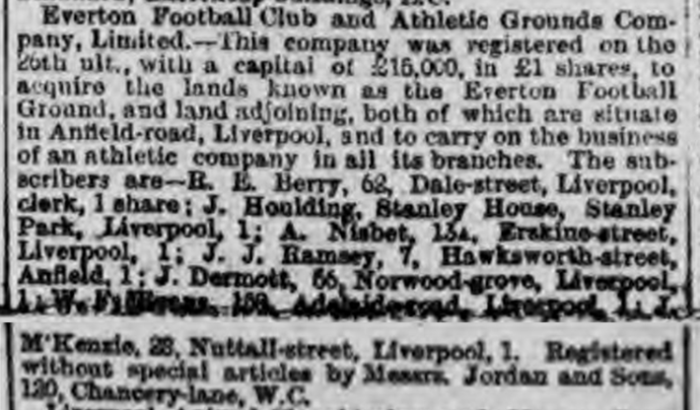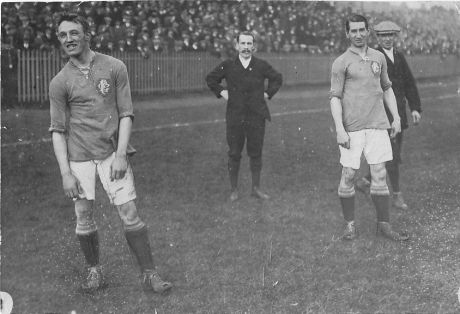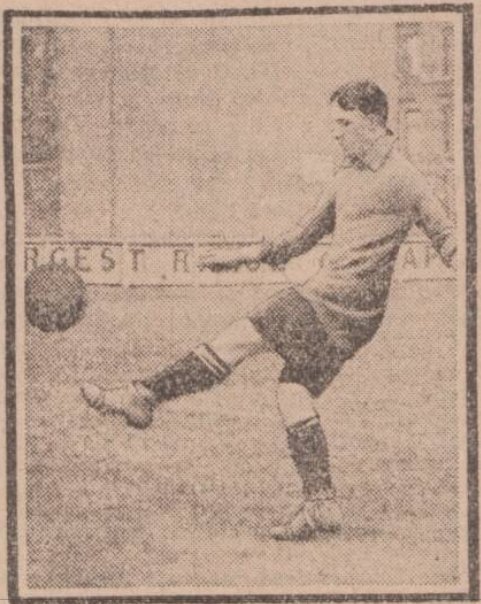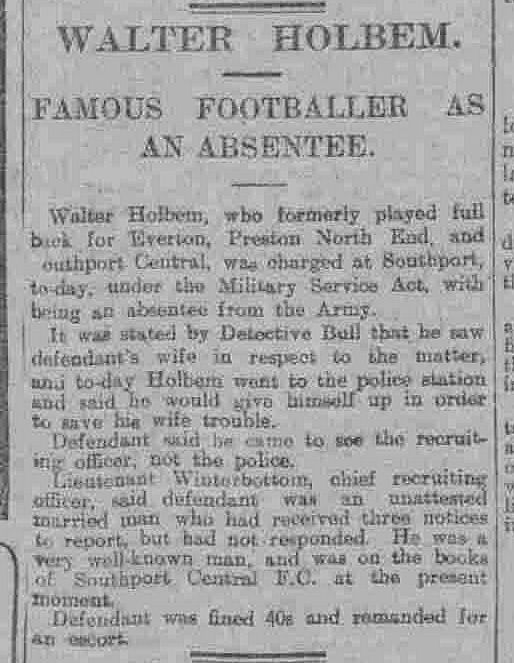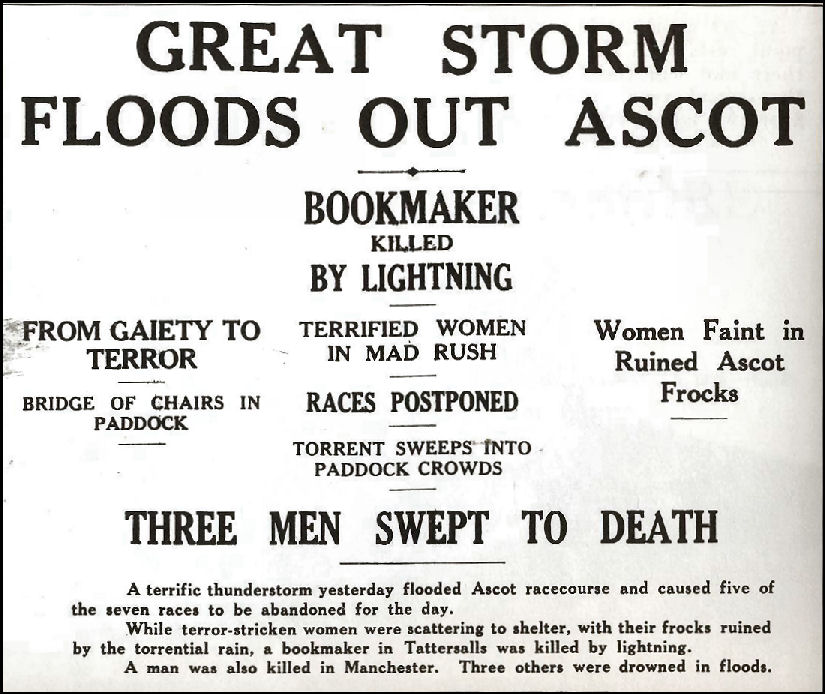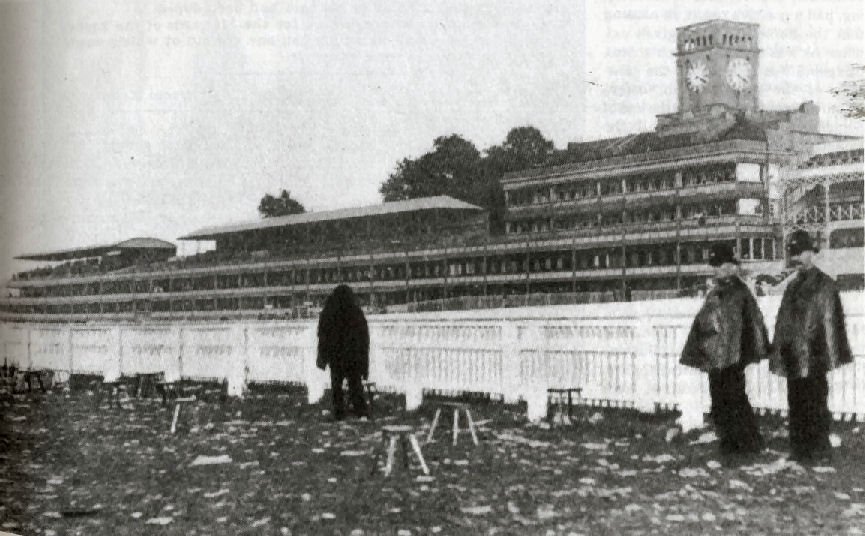Not Kenny Dogs... surely not?
Nah.
The Alternate Everton History Part III
In the summer of 1987, Howard Kendall sensationally resigned as Everton manager, to take the reins at Barcelona. His replacement caused some surprise; rather than an experienced supremo like Venables or Atkinson, Everton opted for Aberdeen's young manager, Alex Ferguson.
1987/88 was a transitional season for Everton; Howard Kendall mercilessly raided his old club, signing Lineker and Steven for a massive combined fee of £6.5M. With Peter Reid losing his effectiveness due to a combination of age and injuries Alex Ferguson was thus compelled to try to replace three Everton legends. He first moved to strengthen the defence, signing Norwich City's centre half, Dave Watson. It was believed that he also wished to sign Watson's partner, Steve Bruce, but this supposed move did not come about at this time. He similarly failed to persuade Ron Atkinson to sell Ian Rush, though the striker was rumoured to be ready to leave Manchester United to join the club he had supported as a boy. However, with the likes of Ratcliffe, Van Den Hauwe, Stevens, Bracewell, Beardsley, McMahon, Sheedy and most of all, Southall, still there, Everton remained the team to beat, and by the season's end they had won the League Cup, were third in the league to Manchester United and Brian Clough's Nottingham Forest, and had reached the final of the European Cup-Winners Cup, losing 3 - 2 to Ajax.
In 1988/89, Everton fought out with Atkinson's Manchester United, George Graham's Arsenal, Terry Venables' Spurs and Brian Clough's Nottingham Forest for the title. Alex Ferguson, who had tasted European glory with Aberdeen, showed that he had not left his magic in Scotland when Everton won the UEFA Cup, beating Barcelona in the semi-final and Sampdoria by 2 - 0 in the final, Paul Bracewell and Peter Beardsley scoring. Arsenal won the League by five points from the Blues, but Everton retained the League Cup and reached the semi-final of the F. A. Cup, losing 2 - 1 to Spurs.
The close of the eighties saw the beginning of the end for some of Everton's "glory boys" as they became known following their all-conquering feats. Van Den Hauwe departed, and with Kevin Ratcliffe plagued by injuries, and Gary Stevens leaving to join his former manager at Barcelona, the defence, the bedrock of the team, was in need of strengthening. Graeme Sharp departed too, as Ferguson started to put his stamp on the team. Ferguson also reorganised the youth set-up, declaring that he wanted to have at least two players from the youths coming into the squad each season.
When Everton failed to lift any silverware in 1989/90, there were rumblings of discontent, and even calls for a "taxi for Ferguson" from disgruntled fans, but the Boards stuck by their man, and Ferguson promised the fans that, given time, he would ensure that the Goodison Park outfit would reign once more.
In the summer of 1990, Ferguson strengthened the team by signing Dave Watson's former partner, Steve Bruce, together with Paul Parker of QPR. The most significant signing, however, was of an unknown young Irish midfielder from Cobh Ramblers named Roy Keane, for a fee of £65,000.
The Everton midfield revolved around Steve McMahon, Kevin Sheedy and Paul Bracewell, but these players were now either in their thirties or fast approaching that age. McMahon was surprisingly sold to neighbours Liverpool, after playing over 300 games for Everton, while injuries were reducing Bracewell’s effectiveness. Ferguson went abroad for midfield reinforcements, signing a Ukranian winger with a name that was, at first, almost unpronounceable by fans - Andrei Kanchelskis. The biggest signing, however, was the capture of the Southampton centre forward, Alan Shearer, for a British record fee of £3,000,000.
In 1990/91, the title was a two-horse race between George Graham's Arsenal and Everton under Alex Ferguson. Shearer had made an instant impact with the Blues, scoring ten times in his first month at the club, and while Kanchelskis' impact was less spectacular, his blistering speed made him a handful for any defence. Indeed, when the two sides met, it was billed in the press as "the immovable force meets the irresistible object", as Arsenal's notoriously mean defence of Seaman, Dixon, Adams, Keown or Bould and Winterburn restricted all opponents to a single goal or less. Arsenal won the first encounter 1 - 0, Ian Wright netting, and the defeat prompted Ferguson to splash out in the transfer market once again, this time buying Newcastle United's talented midfield player Paul Gascoine for a fee of £2M, with Paul Bracewell going the other way.
Though the new team needed time to gel into a unit, it was plain that Everton had the basis of a team to rival the great sides of the 1960s, the 1970s and the 1980s. Neville Southall was still universally regarded as the best keeper in Britain, and other experienced players, like Dave Watson and Peter Beardsley, helped the youngsters along. Though Arsenal won the league once again, Everton achieved success in the cups, winning the UEFA Cup, beating Inter-Milan 3 - 1 and the F. A. Cup, defeating Spurs with goals from Dave Watson and Paul Gascoine.
Football in the 1990s was changing. A fire at Bradford City in the mid-1980s, which resulted in over 50 deaths, and various examples of hooliganism, resulted in reports urging the introduction of all-seater stadia. A new Television deal between the League and a satellite TV company meant that more money was flowing into the game, with the League - Division 1 soon to be replaced by the Premier League. Everton seemed determined to ensure that they would be the last club to win the old First Division championship, winning their first ten league games in succession. Everton were unbeaten in the League until New Year's Day, and won the title by Easter. They also won the European Cup-Winners Cup, defeating Athletico Madrid 3 - 0 in the Final.
Everton were the first team to win the new Premier League in 1992/93. With the solid defence of Bruce and Watson in front of Southall, the brilliant Gascoine in midfield, Kanchelskis on the wing and Shearer and Beardsley up front, nothing could stop the relentless forward march of the Toffeemen. The old Park End was torn down in the summer of 1993 to be replaced by a double-decker structure with Executive Boxes - the Park Stand. This gave Goodison Park an all seated capacity of 45,000, but even this was not enough to meet the demand for tickets, and plans were discussed for replacement of all the stands. Everton seemed to have no real rivals in the domestic game; while Arsenal under George Graham were effective and hard to beat, they were almost universally condemned as being dull to watch and primarily concerned with keeping clean sheets. Ron Atkinson’s Manchester United found it impossible to replace ageing stars Ian Rush and Bryan Robson; some alleged that Atkinson never replaced Kenny Dalglish, who had left to rejoin Celtic in 1988, though it was universally admitted that "King Kenny" was a hard act to follow. Challenges might come from a resurgent Leeds United, back in the top flight after an absence of eight years, or, somewhat unexpectedly, from Liverpool, who, it was said, had some bright stars in their youth team. Also, Chelsea were making noises about becoming "the Everton of the south" under their wealthy backers.
It was soon clear that in hiring Alex Ferguson to replace Kendall, Everton's directors had pulled off a masterstroke. They won the European Cup again - by this time, the competition had been renamed "The UEFA Champions League" and involved a somewhat complicated group format. However, Everton overcame all obstacles to defeat Barcelona 3 - 0 in the final. 1994 also saw Everton retain the Premier League title.
1994/95 was another memorable year for the Blues. They won the title for the third year in succession, though they were eliminated from the Champions League at the semi-final stage. Winning the domestic double of League and Cup was a consolation, however; they defeated Manchester United in the final, Bruce, Shearer and Watson scoring. This was Neville Southall's last game for Everton; the most decorated and capped player in the club's history, and the player who had made most appearances for Everton, Southall had the honour of captaining the club for the final, and it was he who lifted the trophy, having kept yet another clean sheet in the final, despite the efforts of his fellow Welshman, young Ryan Giggs, for United.
Replacing Neville Southall seemed an impossible task, and Ferguson looked beyond the shores of Britain for a worthy candidate to follow Big Neville. He signed the Danish giant, Peter Schmeichel, for £1.5M from Brondby. Ferguson also signed the Scottish defender Richard Gough from Rangers for £1M. By this time, the young Irish midfielder Roy Keane, after a spell on loan at Preston North End, had established himself in the team, and was tipped as a future Everton great.
1995/96 saw further challenges for Everton. Under the management of former favourite Kenny Dalglish, who had replaced the sacked Ron Atkinson in the summer, Manchester United fielded an impressive young side, with emerging stars like Ryan Giggs, Paul Scholes, Gary and Phil Neville, David Beckham and Nicky Butt. Defenders of Atkinson said that he had been denied the chance to work with players that he had developed, and that Dalglish merely benefited from Atkinson's youth policy. Be that as it may, by the autumn of 1995 Manchester United were genuine challengers for the title. Somewhat unexpectedly, Liverpool also showed that they were determined to usurp their neighbours, producing exciting young players like Robbie Fowler and Steve McManaman, ironically both boyhood Evertonians.
At Arsenal, George Graham had left amid allegations of financial misdeeds, and new manager Bruce Rioch proved unable to maintain the Gunners' momentum, with rumours that binge drinking, drug taking and gambling were rife in the club.
Peter Beardsley left Everton to join his home town club, Newcastle United, in their quest for promotion to the Premiership under former favourite Kevin Keegan. His replacement was a powerful Scot, Duncan Ferguson; Ferguson, tall and immensely strong in the air was a completely different type of player to Beardsley, but proved to be a great success at Goodison Park, netting twice against neighbours Liverpool on his debut to help his team to a 3 - 1 win at Anfield. Anders Limpar joined from Arsenal, and Everton had one of the most potent attacks ever seen in England, with Kanchelskis, Ferguson, Shearer and Limpar terrorising defences.
Everton won the Champions League beating Ajax 3 - 1 in the final, incidentally avenging the loss in the 1971 European Cup Final. They also won the League Cup and League Championship, though the F. A. Cup was won by Manchester United's young side, now called "Kenny's Kids", an echo of the "Busby Babes" of the 1950s.
In the summer of 1996, the Bullens Road stand was demolished and rebuilt, increasing Everton's capacity to 50,000, with more executive boxes and improved facilities.
1996/97 was a testing year for Everton. Losing both Shearer and Duncan Ferguson to injuries was a major blow, and when midfield dynamo Roy Keane also had to undergo surgery Alex Ferguson's skills were tested to the utmost. However, Kanchelskis, Limpar and Gascoine still dominated most midfields, and the experience of Gough at the back, together with Peter Schmeichel in goal, meant that Everton were still among the front runners, though they were eliminated from the Champions League at the quarter-final stage. Everton suffered something of a blow to their prestige when neighbours Liverpool did the double over them in the league for the first time for decades, goals coming from Fowler in both games. Alex Ferguson ordered a complete revamp of the youth setup, declaring that he was tired of seeing Liverpool get the best local kids. Youngsters were introduced late on in the season, with full back Michael Ball and forward Danny Cadamateri both making their debuts. Ball went on to become a full international, while Cadamateri had a respectable career in the football league. The League Cup was Everton's sole trophy in 1996/97.
In 1997/98, Shearer and Keane returned, but Duncan Ferguson continued to be plagued by injuries, and manager Alex Ferguson looked to strengthen the side. In an audacious move, he splashed out £10M for Arsenal's Dennis Bergkamp, who had joined the London side two years previously but had shown top form only occasionally for the Gunners under manager Rioch. Duncan Ferguson was subsequently sold to Leeds United for £8M. Ferguson also tried to buy the Manchester United midfielder Paul Scholes, but Dalglish was extremely reluctant to let the player go and no deal was struck. Ferguson subsequently purchased Gary Speed for £6M. This paved the way for Paul Gascoine's departure to Italy, the gifted but undisciplined midfielder having fallen foul of his manager once too often. Players came and went, but Everton under Alex Ferguson continued to flourish, once again winning the domestic double, defeating Chelsea in the Cup Final and ending the season champions, six points ahead of Manchester United.
By 1998/99, the format of the Champions League had changed; no longer was the competition confined to League Champions. However, Everton continued to succeed in Europe, winning the trophy after beating Bayern Munich and Barcelona on the way to the final, where they defeated Juventus 2 - 1. Chelsea beat an under-strength Everton side 3 - 2 in the League Cup Final, but the Blues of Merseyside retained their League title, albeit on goal difference only from Manchester United. Leeds United defeated Liverpool 2 - 0 in the F. A. Cup Final, with former Evertonian Duncan Ferguson scoring both goals for the Yorkshiremen.
By 1999/2000, the Champions League had become a cash cow, and the gap between the "haves" who were in the CL and the "have nots" - the rest of the league - was large and growing. By now too, there were no restrictions on the number of foreigners a team could field, and it was no unknown for Premiership games to take place with no English players on the pitch! Everton had several youth team graduates in the squad - players such as Unsworth, Osman, Hibbert, Jeffers, Barton, Grant and others had occasional games, while Jagielka and Baines eventually became regular first teamers, but more and more of Everton’s strongest XI were either big money buys or foreigners, or both. This was, of course, the case with most clubs, not only Everton. When Peter Schmeichal left Everton, he was replaced by an American, Tim Howard.
1999/2000 was the season of Alex Ferguson's greatest triumph, masterminding Everton's march to a treble of F. A. Cup, League Championship and European Cup. For this feat, Ferguson was knighted. Roy Keane was chosen Footballer of the Year, and Alan Shearer was the league's top scorer with 34 goals. Everton were unbeaten at home and lost only twice in the league in the whole season, away to Arsenal and, somewhat unexpectedly, to newly promoted Manchester City, now managed by former Evertonian Joe Royle. Spurs were despatched 2 - 0 in the F. A. Cup Final, and Everton defeated Valencia after extra time in the final of the European Cup.
In 2000, the idea of moving Everton from their home at Goodison Park to a new stadium was mooted. There were problems with the attempted expansion of Goodison, and a site was found on the waterfront, at King's Dock. This would put Everton in a new ground at the very heart of the city, and although there were some protests amongst disgruntled fan groups, a ballot of the fans gave the scheme the support of over 87% of those voting.
On the field, Everton under Ferguson kept on winning trophies, and comparisons were made with the great side of the mid 80s. In 2002, a debut was given to a 16 year old forward named Wayne Rooney. He made his mark on the Premiership with a spectacular goal against Arsenal, and inspired the most memorable quote from a commentator since Kenneth Wolstenhome's "They think it's all over" in 1966, with "Remember the name - Wayne Rooney!" A year later, with Rooney gradually establishing himself as a regular, Everton signed the Australian inside forward Tim Cahill for £1.75M from Millwall, following an inspired performance by Cahill against Everton in the semi-final of the F. A. Cup.
In 2004, Sir Alex brought in a younger man as his assistant - David Moyes, the manager of Preston North End, who had narrowly failed to get promotion to the Premiership. It was widely thought that Ferguson saw Moyes as his eventual successor. In any event, Everton won the Champions League again in 2005 and 2006, as well as several domestic honours. It was fitting that Everton's last game at Goodison Park in May 2005 saw them lift the Premier League trophy again, and that the last goals score at that ground were by Shearer, who had established a post-war record total for Everton, and Rooney, universally seen as Shearer's natural successor.
The 2005/06 season dawned with Everton in their new 55,000 seater stadium at the King's Dock, ready to meet the challenge of defending their League title and European Cup.
New challengers emerged, and under billionaire owners, Chelsea and then Manchester City tried to challenge Everton's pre-eminence, but to no avail. With their massive fan base widened by almost fifty years' continuous success, Everton were supreme in England and Europe. When Sir Alex retired as Everton's manager at the end of season 2007/08 at the age of 65, he was succeeded by his assistant, David Moyes, who in his first season, guided the club to yet another domestic "double" and a Champions League win. Already, there was talk of extending the capacity of Everton's new ground, from the 55,000 it held to a staggering 75,000.
Concluded.
It does tend to get a bit fanciful towards the end, but hey, it's fiction
How long does Moyes last (not too long I hope)
where do Martinez, Moshiri and Koeman fit in this, if at all.
I fancy Mourinho to be in there some where.
anybody? fell free to move it on from 2007.


